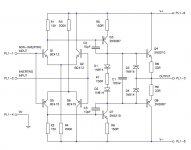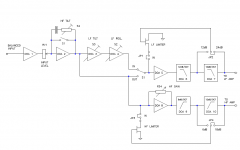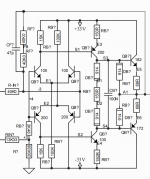Hi! Im working on a discrete opamp. Im trying to replace input pairs with something good as the old BC413c/BC415c it has in there.
After some research I have found this TOSHIBA device: HN4C06J
This is to replace the original opamps of an equipment I use a lot and I need to repair. Im making a new PCB layout for them so maybe I use them for another project.
I saw this desing in another threads before with PN100/200 transistors, now obsolete too. the BCs apears to be better though
Any advice?
Thanks!
After some research I have found this TOSHIBA device: HN4C06J
This is to replace the original opamps of an equipment I use a lot and I need to repair. Im making a new PCB layout for them so maybe I use them for another project.
I saw this desing in another threads before with PN100/200 transistors, now obsolete too. the BCs apears to be better though
Any advice?
Thanks!
Attachments
Looks a reasonable NPN pair - there's also HN4B06J which may be the complementary device.
yeah, I have doubts about the noise figure, datasheet only shows the "Typ." value while the old ones used to show the Maximum more often. I think the only way to know would be to try them...Looks a reasonable NPN pair - there's also HN4B06J which may be the complementary device.
The moving coil pre-preamp design community seems to favor Zetex bipolar transistors for lowest voltage noise, and Toshiba JFETs for lowest current noise. They are pretty much all in agreement that the (extensive!) tables in "The Art Of Electronics (3rd edition)" do correctly indicate the lowest noise devices. Find threads here about Richard Lee's MC head amp.
"there's also HN4B06J..."
Can you suggest where I might be able to get some ?
Also did they specific hfe match for NPN tp PNP ?
"The moving coil pre-preamp design community seems to favor Zetex bipolar transistors for lowest voltage noise"
They have a low impedance source and don't care about input (base) current.
Cheers,
Patrick
Can you suggest where I might be able to get some ?
Also did they specific hfe match for NPN tp PNP ?
"The moving coil pre-preamp design community seems to favor Zetex bipolar transistors for lowest voltage noise"
They have a low impedance source and don't care about input (base) current.
Cheers,
Patrick
Yes Im aware, it seems odd to me that it is so difficult to find a low noise transistor and the fact that what ends to be the best of all, doesn't even show noise figure on datasheet. but I dont know I may be missing something.The moving coil pre-preamp design community seems to favor Zetex bipolar transistors for lowest voltage noise, and Toshiba JFETs for lowest current noise. They are pretty much all in agreement that the (extensive!) tables in "The Art Of Electronics (3rd edition)" do correctly indicate the lowest noise devices. Find threads here about Richard Lee's MC head amp.
I have that book, and I was considering the ZTX851/951 as candidates, but as stated on the book it apears that they perform better at a higher currents, that means that I need to start tweaking the opamp desing and I dont want to do that much. Im hoping that I can find a suitable and reliable device to simply replace the BCs transistors with same or better performance.
Yes Im planning to use both, they are active and available on Mouser. They dont say anything about matching though. the Bcs I took out from the original opamps doesnt seem to be matched neither."there's also HN4B06J..."
Can you suggest where I might be able to get some ?
Also did they specific hfe match for NPN tp PNP ?
"The moving coil pre-preamp design community seems to favor Zetex bipolar transistors for lowest voltage noise"
They have a low impedance source and don't care about input (base) current.
Cheers,
Patrick
The HN4B06J states 20mA of base current, the BCs dont show that on datasheet...
This opamp is an interstage DOA of a reference monitor amplifier, they perform input, crossover and limiting functions before the pwr amps.
What you think?
Thanks!!
I asked in post #6 :
"there's also HN4B06J..."
Can you suggest where I might be able to get some ?
Also did they specific hfe match for NPN to PNP ?
HN4C06J you posted above is 2x NPN.
HN4B06J is 1x PNP + 1x NPN.
If you can find a source for HN4B06J, it would be great.
Thx,
Patrick
"there's also HN4B06J..."
Can you suggest where I might be able to get some ?
Also did they specific hfe match for NPN to PNP ?
HN4C06J you posted above is 2x NPN.
HN4B06J is 1x PNP + 1x NPN.
If you can find a source for HN4B06J, it would be great.
Thx,
Patrick
One thing to be clear about when designing an opamp is what it is for.The moving coil pre-preamp design community seems to favor Zetex bipolar transistors for lowest voltage noise, and Toshiba JFETs for lowest current noise. They are pretty much all in agreement that the (extensive!) tables in "The Art Of Electronics (3rd edition)" do correctly indicate the lowest noise devices. Find threads here about Richard Lee's MC head amp.
For general signal processing (such as fixed gain stages and active filters) you'd expect impedances in the 1k to 20k range, and probably want to optimize the noise performance at around 5k, suggesting voltage-noise to current-noise ratio of 5000.
This implies using BJT inputs with something in the region of 5nV and 1pA noise densities or better (in that ratio), which is achievable with BJTs. The best JFETs can fulfil these requirements too, and extend the impedance range up to 100k+.
However such high source impedances are rarely met in audio (except for bare condenser mic capsules).
However FET inputs are extremely useful for simplifying level and EQ controls where having to put a capacitor inline with every pot wiper is required for BJT opamps (due to the severe noise if the pot is the slightest bit scratchy). FET inputs have so little bias current that the input capacitance can supply it during short periods of pot wiper intermittency, preventing the slam-to-the-rail behaviour of BJT opamps in this situation (without caps and separate DC bias paths).
Noise impedance is an important thing to understand - for instance an AD797 is a high noise device if used for an MM cartridge, despite being low noise for an MC cartridge... All due to noise performace having an optimal impedance range.
"such high source impedances are rarely met in audio"
Sallen Key filters (without having to use large caps).
Patrick
Sallen Key filters (without having to use large caps).
Patrick
Im sorry man, my mistake. I did a search and that one apears to be more dificult to get in deed.I asked in post #6 :
"there's also HN4B06J..."
Can you suggest where I might be able to get some ?
Also did they specific hfe match for NPN to PNP ?
HN4C06J you posted above is 2x NPN.
HN4B06J is 1x PNP + 1x NPN.
If you can find a source for HN4B06J, it would be great.
Thx,
Patrick
Hi Mark, thanks for the clarification. As I mentioned before, this op-amp is exactly the case for general signal processing, fixed gain, and active filtering. I really want to get some input on the toshiba device I chose, as a replacement and maybe an upgrade over the original BC413/415. Perhaps someone with more experience on this matter can point you in the right direction.One thing to be clear about when designing an opamp is what it is for.
For general signal processing (such as fixed gain stages and active filters) you'd expect impedances in the 1k to 20k range, and probably want to optimize the noise performance at around 5k, suggesting voltage-noise to current-noise ratio of 5000.
This implies using BJT inputs with something in the region of 5nV and 1pA noise densities or better (in that ratio), which is achievable with BJTs. The best JFETs can fulfil these requirements too, and extend the impedance range up to 100k+.
However such high source impedances are rarely met in audio (except for bare condenser mic capsules).
However FET inputs are extremely useful for simplifying level and EQ controls where having to put a capacitor inline with every pot wiper is required for BJT opamps (due to the severe noise if the pot is the slightest bit scratchy). FET inputs have so little bias current that the input capacitance can supply it during short periods of pot wiper intermittency, preventing the slam-to-the-rail behaviour of BJT opamps in this situation (without caps and separate DC bias paths).
Noise impedance is an important thing to understand - for instance an AD797 is a high noise device if used for an MM cartridge, despite being low noise for an MC cartridge... All due to noise performace having an optimal impedance range.
Noise wise it seems to be as good as the BC. Patrick also mentions the base current thing, I'm not sure about that...
I'm not a super expert but I think combining these transistors would also be a good thing and I think these Toshiba transistors should be more accurate than new old parts.
what you think?
thanks!
Attachments
Hi! look, I don't really want to post schematics of entire circuit here because the person who gave it to me said not to do that...Ok can you share more details about it, then will be able to share my views on it. Also check x8 speeder apk
I think I already show enough. I posted a block diagram, it is just 5 opamps running on 24V, DC coupled one after the other. Only between DOA1 & 2 there´s a capacitor probably to block some DC through the pot.
Thanks!
Canadian high end audio manufacturer Bryston used to give away the schematics of their discontinued products, as downloads on their website. But now it appears, they've stopped.
Here's a Discrete Op Amp ("DOA") from the Bryston model 28B. "100" means PN100, "200" means PN200, "182" means MJE182, "172" means MJE172, and "914" means 1N914.
_
Here's a Discrete Op Amp ("DOA") from the Bryston model 28B. "100" means PN100, "200" means PN200, "182" means MJE182, "172" means MJE172, and "914" means 1N914.
_
Attachments
Probably - though you do have to look out for the "typical" v. "maximum" noise specs - arguably the first is meaningless because it means they probably aren't screening production for noise performance, and that might mean a significant fraction are poor (witness the LM4562 noise issues for instance). You might have to do some bench testing to gain confidence in the devices if only "typical" figures are quoted.Noise wise it seems to be as good as the BC. Patrick also mentions the base current thing, I'm not sure about that...
"accurate" - do you mean in voltage offset? That should be in the datasheet. That will depend how they are constructed, precision opamps use inter-digitated input devices meaning they are extremely accurate at thermal tracking and insensitive to thermal gradients on the die - a matched transistor pair might just be two transistors side-by-side, or might be interdigitated - the offset voltage specs ought to allow comparison for this.I'm not a super expert but I think combining these transistors would also be a good thing and I think these Toshiba transistors should be more accurate than new old parts.
what you think?
Nice! well I have to say that we are talking about the same manufacturer, but I think for this aplication they want to go better than the PNs for the input devices. Unfortunately, this transistors (PN100a/200a) are obsolete.Canadian high end audio manufacturer Bryston used to give away the schematics of their discontinued products, as downloads on their website. But now it appears, they've stopped.
Here's a Discrete Op Amp ("DOA") from the Bryston model 28B. "100" means PN100, "200" means PN200, "182" means MJE182, "172" means MJE172, and "914" means 1N914.
_
I understand, the Typ. noise figure doesnt seem like much of a guarantee. The original BC413 has a max. noise figure of 2.5db so I want to be sure that is the worst I would get.Probably - though you do have to look out for the "typical" v. "maximum" noise specs - arguably the first is meaningless because it means they probably aren't screening production for noise performance, and that might mean a significant fraction are poor (witness the LM4562 noise issues for instance). You might have to do some bench testing to gain confidence in the devices if only "typical" figures are quoted.
"accurate" - do you mean in voltage offset? That should be in the datasheet. That will depend how they are constructed, precision opamps use inter-digitated input devices meaning they are extremely accurate at thermal tracking and insensitive to thermal gradients on the die - a matched transistor pair might just be two transistors side-by-side, or might be interdigitated - the offset voltage specs ought to allow comparison for this.
I thinking that may be better to get back to the ZTX851/951 idea. Can you give me some help on how to implement this device properly on this circuit?
my other candidates are PN4250A/PN2484 or 2N5210/2N5087
Devices Im considering so far>
MPS6521/MPS6522: good specs low voltage thogh
MPS8097> may be a good complement of MPSA18 makes sense?
MPS8099/MPS8599> found those inside GML 8200 opamp!
MPS6521/MPS6522: good specs low voltage thogh
MPS8097> may be a good complement of MPSA18 makes sense?
MPS8099/MPS8599> found those inside GML 8200 opamp!
- Home
- Source & Line
- Analog Line Level
- Discrete Opamp advice


